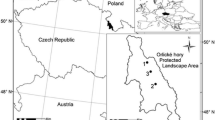Abstract
The development of the epiphytic lichen vegetation on tree trunks inside and nearby twelve towns and industrial areas in south-west Sweden was investigated 1986/88 and 1997 using a photographic technique. The lichen vegetation studied in terms of area cover as well as the air pollution sensitivity and preference for nitrogen of the individual lichens. During both surveys the lichen flora was strongly impoverished in urban areas compared to suburban areas and especially to the countryside (reference) areas nearby. The air pollution situation has improved in the area both before and during the study period. This holds especially for SO2, to a lesser extent also for NO2. Following the improvement of the air quality, an increased lichen area cover on the tree trunks was observed. Also the cumulative pollution sensitivity of the lichens present was higher in 1997 compared to 1986/88 in suburban and countryside areas. For the nitrogen impact, the increase from 1986/88 to 1997 was smaller than for pollution sensitivity, but still statistically significant. The trends are interpreted as signs of a normalisation of the lichen flora. It is concluded that the observed pattern of lichen recovery reflects the fact that the reduction of the air pollution level in the central parts of the towns is still not large enough to permit a large-scale recovery of the lichen flora, while in the suburban areas and the countryside next to the towns, the air quality has now improved to an extent, which permits the reinvasion of a number of lichens.
Similar content being viewed by others
References
Amann, M. : 2001, ‘Emission inventories, emission control options and control strategies: an overview of recent developments’, Water, Air, Soil Pollut. 130, 43.
Barkman, J. J. : 1958, Phytosociology and Ecology of Cryptogamic Epiphytes, Assen, Van Gorcum, 628 pp.
Brawn, K. and Ogden, J. G. : 1976, ‘Lichen diversity and abundance as affected by traffic volume in an urban environment’, Urban Ecology 2, 235—244.
Geebelen, W. and Hoffman, M. : 2001, ‘Evaluation of bio-indication methods using epiphytes by correlating with SO2-pollution parameters’, Lichenologist 33, 249—260.
Gilbert, O. L. : 1992, ‘Lichen reinvasion with declining air pollution’, in J. W. Bates and A. M. Farmer, (eds), Bryophytes and Lichens in a Changing Environment, Clarendon Press, Oxford.
Grindon, L. H. : 1859, The Manchester flora, W. White, London, 575 pp.
Hawksworth, D. L. and Rose, F. : 1976, Lichens as Air Pollution Monitors, Arnold, London, 60 pp.
Hultengren, S., Martinsson, P. -O. and Stenström, J. : 1991, ‘Lichens and air pollution’, Swedish Environmental Protection Agency Report 3967, 58 pp. (In Swedish with a summary in English)
LeBlanc, F., Rao, D. N. and Comeau, G. : 1972, ‘Indices of atmospheric purity and fluoride pattern in Arvida, Quebec’, Can. J. Bot. 50, 991—998.
Marti, J. : 1983, ‘Sensitivity of lichen phycobionts to dissolved air pollutants’, Can. J. Bot. 61, 1647— 1653.
McCune, B. : 1988, ‘Lichen communities along O3 and SO2 gradients in Indianapolis’, The Bryologist 9, 223—228.
Nylander, W. : 1866, ‘Les lichens du Jardin du Luxembourg’, Bull. Soc. Bot. Fr. 13, 364—372.
Santesson, R. : 1993, The Lichens and Lichenicolous Fungi of Sweden and Norway, SBT-förlaget, Lund, 240 pp.
Skye, E. : 1968, ‘Lichens and air pollution. A study of cryptogamic epiphytes and environment in the Stockholm region’, Acta Phytogeographica Suecica 52, 123.
Showman, R. E. : 1990, ‘Lichen recolonization in the upper Ohio River valley’, The Bryologist 93, 427—428.
Showman, R. E. : 1997, ‘Continuing lichen recolonization in the upper Ohio river valley’, The Bryologist 100, 478—481.
Svanberg, P. -A. and Lindskog, A. : 2000, ‘Air Quality in Sweden Summer 1999 andWinter 1999/00’, IVL Report B1388, 88 pp. (in Swedish with a summary in English)
Tyler, G. : 1989, ‘Uptake, retention and toxicity of heavy metals in lichens’, Water, Air, Soil Pollut. 47, 321—333.
van Dobben, H. F. : 1996, ‘Decline and recovery of epiphytic lichens in an agricultural area in The Netherlands (1900—1988)’, Nova Hedwigia 62, 477—485.
van Dobben, H. F. and ter Braak, C. J. F. : 1999, ‘Ranking of epiphytic lichen sensitivity to air pollution using survey data: a comparison of indicator scales’, Lichenologist 31, 27—39.
van Herk, C. M. : 2001, ‘Bark pH and susceptibility to toxic air pollutants as independent causes of changes in epiphytic lichen composition in space and time’, Lichenologist 33, 419.
Wirth, V. : 1995, Die Flechten Baden-Württembergs, Ulmer, Stuttgart.
Wirth, V. : 1993, ‘Trendwende bei der Ausbreitung der anthropogen gefördeten Flechte Lecanora conizaeoides’, Phytocoenologia 23, 625—636.
Author information
Authors and Affiliations
Corresponding author
Rights and permissions
About this article
Cite this article
Hultengren, S., Gralén, H. & Pleijel, H. Recovery of the Epiphytic Lichen Flora Following Air Quality Improvement in South-West Sweden. Water, Air, & Soil Pollution 154, 203–211 (2004). https://doi.org/10.1023/B:WATE.0000022967.35036.ca
Issue Date:
DOI: https://doi.org/10.1023/B:WATE.0000022967.35036.ca




